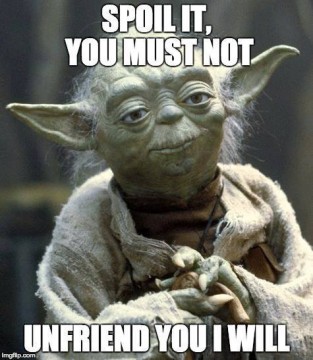Want to be a Marketing Jedi? This IS the Post You’re Looking For
Selene Benjamin
Feature image courtesy JD Hancock
Another Star Wars post? Really?
Given the buzz around Star Wars this week, it was bound to happen: tons of posts, all looking to take advantage of the huge number of people talking about the film.
But how did we get here?
How did a little movie in a notoriously unprofitable genre that nobody wanted to make become not just an instant hit but completely alter the entire movie-making universe?
And what in a galaxy far, far away does this have to do with you?
The answer to both questions? Marketing.
Not to get all cliché on you… but oh hell, why not? Star Wars is a marketing juggernaut. And while your business might not have the mass appeal or reach of the Star Wars universe, there are lessons to be learned from a movie nobody believed in—well, except for Steven Spielberg—that became a movie franchise loved by all.
I think it’s safe to say Star Wars is pretty mainstream these days. Hello, Disney owns it (and in fact, paid $4 billion to do so).
But billion dollar deals and instant viral posts start somewhere, so let’s start at the beginning…
Everyone Knows There’s No $$$ In Sci-Fi

Fresh off the success of American Graffiti, George Lucas started shopping around his space western idea, an idea even he didn’t really believe in. Why? Sci-fi was not exactly pulling in the big bucks back in the 70s.
Lucas himself said after an impressive opening weekend, “It’s a science fiction film. Science fiction films get a good old group of sci-fi fans. They’ll go to anything the first week. Wait for a couple weeks, and you’ll see what it’s really gonna do.”
But even knowing sci-fi only had a small (but dedicated) core group of fans, he stuck with his chosen genre. What would have happened if he had decided to add other story elements to make the movie appeal to everyone?
He didn’t say, “You know, that Hee Haw show is pretty popular, and so is M*A*S*H*. I should throw in a guy in a dress, and some other guy playing a banjo making jokes.” Nor did he think, “Man, I don’t want to cast this carpenter guy as Han Solo. But people sure do love that Fonzie.”
Sound familiar? Maybe you’ve heard us say something like “pick a niche”? Or “if you try to serve everyone, you’ll end up serving no one”?
George Lucas wrote for the fans. He didn’t give up just because nobody wanted to make his film. And wouldn’t you know it, those films ended up appealing to almost everybody.
Start With a Quality Product
Of course, without a damn good movie to begin with, none of it would have mattered. In addition to sticking to his genre/niche, Lucas focused on making the best movie he could.
There were always plans to market the movie, and to market it well, but as Lucas said, “My main focus is just making the movie.”
Inspired by The Hidden Fortress and Flash Gordon, Lucas didn’t have a totally unique idea. But what he did was put his own unique spin on the ageless hero story.
Armed with the best movie he could write and groundbreaking special effects, which led to the creation of his company Lucasfilms, he created a quality product that touched people right in the (relatable) feels:
- Good versus evil.
- A young everyman from nowhere special with no special skills comes to find out he IS from somewhere special—and talk about some special skills.
- A princess who needs saving, but then turns out to be a badass herself!
In fact, it still does. So much so that people who grew up loving Star Wars can’t wait to share that experience with their own kids creating new fans in every generation.
Leverage Partnerships to Build Buzz
By the time the movie premiered on May 25, 1977, there was already a novelization and a Marvel comic book series, AND Time Magazine named it the Movie of the Year.
What’s the lesson here? Partnerships!
Just like our very own Danny Iny, Star Wars leveraged the power of other people’s audiences to grow its own.

That’s not to say it was easy; they worked hard for it. Stan Lee wasn’t immediately sold on the Star Wars comic idea. He, along with DC and Warren, said no. Thankfully, Marvel changed their minds.
Then Lucas and the VP of promotions, Charles Lippincott, continued creating buzz for the book, comics and movie by going straight to their target market, sci-fi and comic book conventions.
By the time the movie premiered, there was already a built-in fan base. Coupled with Jaws—the previous summer’s hit—the summer blockbuster was born, something we continue to love/endure to this day.
This is a huge reason Danny grew Firepole Marketing so quickly. He created a huge buzz by guest posting and appearing as if he was everywhere.
Create (Genuine) Scarcity
Now, we’re all familiar with the scarcity tactic employed by any number of marketers. “Buy it now before it’s gone forever!” Sometimes it’s genuine, but sometimes… not so much.
By Christmas 1977, toy merchandiser Kenner’s scarcity tactic was one of the genuine ones. Nobody expected Star Wars to take off the way it did, so Kenner didn’t have enough toys to go around.
What did they do? They sold vouchers. Kids around the country literally got an empty box under the Christmas tree with the promise of a toy.
Did it work? Uhhh… does Yoda use the dark side to hide in a swamp?
Scarcity works, particularly when it’s genuine. It forces people to make a decision.
However, it’s also important to not abuse it. It’s not like Kenner thought, “Yeah, we’ll sell empty boxes! People will eat it up!” Imagine the backlash if the fans found out about that.
Once you lose your customer’s trust, you lose.
Pivot to Message

Let’s talk about when things don’t go according to plan:
The prequels. Oh, the prequels. Is anyone unfamiliar with that disaster? It’s so painful that I can’t really linger here for long.
In the 1990s, George Lucas released some films. Prequels to Star Wars.
Long story short, they were awful—and fans everywhere wept, and continue to weep, their midi-chlorians out.
So I think it’s fair to say, the prequels were a big fail. But this fail did not signal the end of the Force. Far from it.
Instead, we could call the shift from the disastrous prequels that made hating Star Wars the new de rigueur to the excitement about the sale to Disney and the new movies a pivot.
As Danny said of pivoting in a recent post, “It’s an adjustment, a strategic relocation, a change in direction that you make while keeping your eye on your goal.”
So What Now?
Something that always takes me by surprise is the amount of money spent on things, particularly in Hollywoodland.
And after I got over the initial shock of Disney buying Lucasfilms and the rights to Star Wars for $4 billion, I realized a couple of things.
One, there’s plenty of money out there, so my little overspend at Target doesn’t matter.
And two, if Disney spent that much to buy it and they continue to spend money on marketing, marketing is incredibly important—even with the built-in fan base.
Even with all the free press from any number of sources (including every single blog post and social share about Star Wars that’s been written this week), marketing never ends.
 I could delve into a marketing case study for the new film that I’m beyond excited to see tonight but the good folks over at ahrefs already did an amazing job of that here.
I could delve into a marketing case study for the new film that I’m beyond excited to see tonight but the good folks over at ahrefs already did an amazing job of that here.
With more than $100 million in presales, and an estimated $9.6 billion for the first year, it looks like that initial $4 billion deal paid off.
I’m curious, though, to see if there comes a time when we start to suffer from Star Wars fatigue. Marketing is a good thing, but nobody wants too much of a good thing.
Now it’s your turn. Any takeaways from Star Wars and Disney’s marketing? Are you excited to see the movie, or are you tired of people talking about it already‽ Please remember, no spoilers! Let’s give everyone a chance to see it.
Rocky
It’s hard to forget that Star Wars, one of the biggest media juggernauts of our time, started small. Selene, great post for breaking down how Star Wars got to where it is now!
Selene Benjamin
Thank you! It was a lot of fun to write 🙂